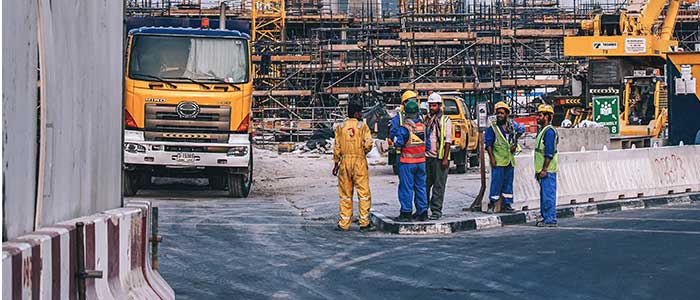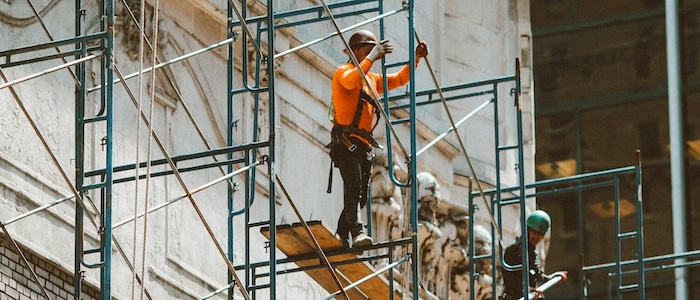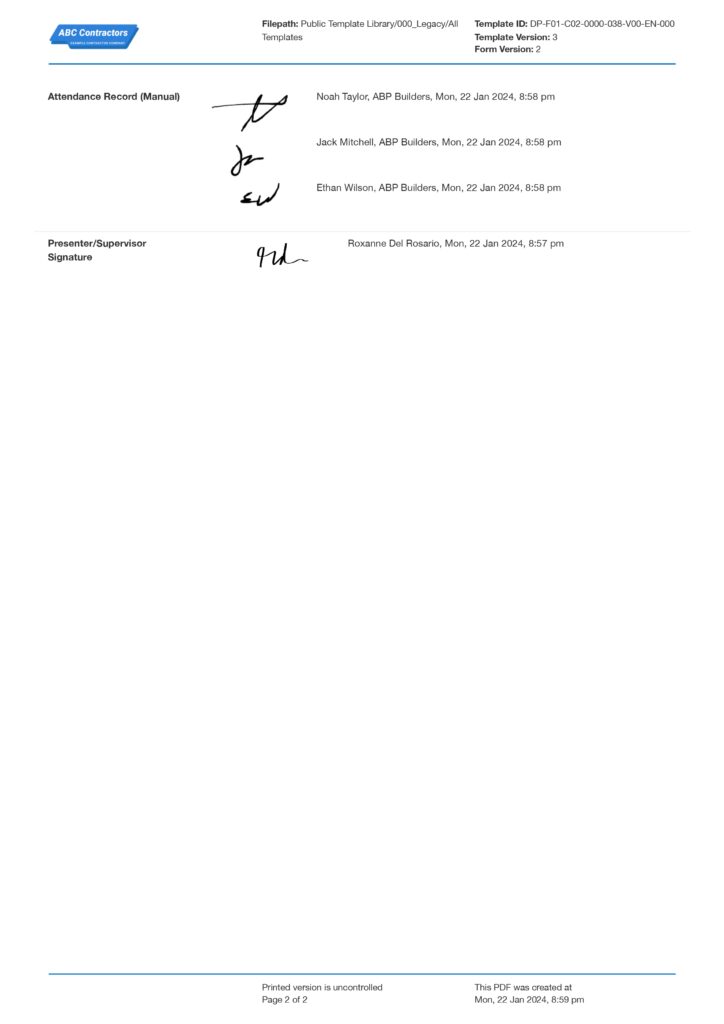Dashpivot Article – Safety Moment Working at Height
Safety Moment Working at Height
In this article, we will address safety moment meetings about working at heights, and show you how to make your safety moments better.

Safety Moments: Working at Heights in Construction
Working at heights is a typical practice in the construction sector. In actuality, it is involved in a lot of different activities in construction. The building of scaffolds is among the most well-known practices. To provide workers a standing space while working at heights, this activity entails creating a temporary platform, usually composed of poles and boards. Ironically, this activity has the potential to escalate to hazardous and lethal heights.
Having said that, safety moments are one of the most perfect avenues to discuss such matters. Safety moments are intended to assist employees in comprehending the risks, hazards, and dangers associated with certain actions. The purpose of these thorough and targeted formal conversations is to emphasise safety while doing a particular task, which in this instance is working at heights.
Safety Moment Working at Height Discussion Points
We have understood that safety moments are a way to reinforce safety in the workplace. However, this will only become effective if the topics in the meeting are targeted and relevant to the activity being highlighted. For this article, we will place our focus on what topics to discuss when dealing with activities that involve working at heights. We will provide you with the appropriate discussion points that you can use when deliberating this topic in your safety moments. Here are our recommended discussion points for activities involving working at heights in construction:
Fall Protection Systems
Fall protection systems are devised safety measures to eliminate the possibility of a fall or prevent injuries when working at heights. These safety controls have been made a requirement by the Occupational Safety and Health Administration under certain conditions, for they have recognised the rampant incidents with falling at heights, . OSHA subpart M lays out the requirements and criteria for fall protection in construction workplaces. When fall protection is implemented in the workplace, workers must understand how they work and what their purpose is. Complete knowledge of the fall protection systems at work can help fully utilise the effectiveness of these safety measures. Having said this, explaining the fall protection systems established would be a great discussion point in your safety moments meeting.
Ladder Safety
Ladders are quite basic devices that have been utilised to assist mankind in ascending to inaccessible places. These things are so common that we even have them in our home. However, ladders may become a health and safety hazard in a number of scenarios due to circumstances that make their usage risky. These dangerous circumstances involving ladder use are increasingly common in the construction sector. You may address ladder safety standards during your safety moments meeting to assist staff in becoming more aware of such hazardous circumstances. Being aware of the risks is the first step towards exercising care and following safety procedures at work.
Scaffolding Safety
Like we formerly said in the paragraph above, scaffolding is an activity that is widely utilised in the construction industry. However, while they can provide a safe working area for workers when working at heights, constructing it and working around it also presents fall from heights hazards, which is ironic. Additionally, OSHA has provided regulations when working on scaffolds and constructing scaffolds. These regulations are critical measures to maintain a safe and working area. With this said, educating your workers about these regulations on your safety moments can urge them to practice the correct safety steps when working and constructing scaffolds. There is better implementation and action when regulations are being shared and explained in safety moments to each person.
Guardrails and Handrails
These are the simplest devices that can prevent a fall. These barriers are placed along edges, especially in areas where a fall is of high possibility. Aside from being a barrier, it can also be a communication device that shows caution that beyond the point where they erected is dangerous or hazardous. These stationary devices go far beyond their simplicity in protecting people in any industry. However, because of its simplicity, there are limitations on the capacity that they can protect workers. This needs to be discussed with your workers to provide understanding on these limitations. Safety moments are one of the best avenues to discuss these kinds of matters. The thoroughness and detailed nature of the discussion in these meetings can help workers fully grasp what kind of limitations those guardrails and handrails can offer.
Equipment Inspection
Equipment inspection is always a vital step before and after doing an activity. This ensures that the equipment is fully operational and is safe to use during a specific activity. This is also true for safety measures and controls. Fall protection devices must be inspected frequently to ensure their effectiveness to prevent falls or mitigate the effects of falls down to a minimum. Assurance that these devices work can help grow efficiency in completing tasks, as workers would not need not hesitate since their lives are not placed at risk. Having said this, proper and thorough inspection is a need to be oriented at safety moments. Having a full grasp on how and why the equipment needs to be inspected allows your workers to develop accountability to protect their lives and the lives of others.
Tools and Material Handling
Tools and materials are almost present in every aspect of construction activities. They are used since they can get things done accurately and faster. Although, there are situations that can elevate the hazards of a certain activity when using these tools and materials . One of the best examples is when working at heights. To paint a picture, imagine you are 4 stories above the ground, standing on a platform on a scaffold. You are using the nailgun to embed some materials on the wall. However, the way you’re holding it is incorrect, and because of this, the recoil of the nail gun causes you to lose your balance and fall. During your safety moments meeting, you can discuss proper parameters and proper procedures when using tools and materials, especially in situations that can escalate the hazards, like working at heights.
Risks Assessments
The document enumerates every potential risk connected with an activity, defines the risks, and offers the necessary controls to reduce and eliminate the risks. The hazards are found by going over each step of a certain activity and identifying any potential risks associated with that particular step. This level of thoroughness ensures that all necessary precautions are taken to get rid of these risks. Having said that, you may enhance the risk assessments by talking about them at your safety moments meeting. Your employees may have firsthand knowledge of the risks associated with engaging in certain activities, especially when working at heights. The activity becomes safer than it has ever been when more dangers are found in your risk assessment and more suitable controls are created.
Weather
Most of the time, activities involved in construction, especially when working at heights, are exposed to weather conditions. Weather conditions are a huge factor in employees safety when doing outdoor activities. Too much heat from the sun can cause heat stress, heavy rain can impair vision and can increase the risks of slips and falls, and heavy winds can destabilise equipment, causing workers to lose their balance. Proper awareness of these factors needs to be communicated to the workers inorder to help them remember the required safety measures to protect themselves from these hazards associated with the weather. This could be properly discussed during safety moments meetings.
Emergency Response Plans
Emergencies are unforeseen occurrences that may take place in the workplace. These situations can either be caused by natural disasters, such as earthquakes and landslides, or by human activities, such as fires and chemical spills. Regardless of the circumstances, it is essential that workers constantly be ready to meet adversities of this kind. In the meetings that you have for safety moments, it is very necessary that the emergency response plan be a topic of discussion. This need is to provide a comprehensive description of what to do in the event of an emergency, since it is essential for the workers' survival in the event of an emergency. It is imperative that they be taught all of the appropriate procedures that are included in the emergency response plan.

Use this working at height safety moment doc for free
A Digital Approach to Safety Moment Talks and Ideas
We have shown how safety moments contribute to workplace safety. Making a safety moment by hand, however, might be a bit time-consuming. It may be a little frustrating that the printing and reformatting are done so often. Moreover, a number of applications, including office ones, must be launched in order to create the form and enter the data, which utilises a lot of time and increases the risk of mistakes. Thankfully, there is now an app that simplifies things.
With the Dashpivot Safety Moment App, you can use a digital form, which you can create using a sophisticated form builder, or simply choose a pre-made form from one of the app template library's free safety moment idea templates.
Tables, date fields, digital hand signings, or fully contactless signatures may give you the most out of your safety moment meetings form by removing the need to constantly print forms and utilise several applications to convert them.
You may also use the digital file without worrying about the internet. While on the field, you can use the Safety Moment Talk app while offline. Once you have supplied the necessary data from your meetings, you can just save the file and upload it later when the internet is available.
Any completed or pre-made safety moment meetings may also be easily located, updated, or converted into a professionally created PDF document online, where they are automatically structured and kept.
To do all of these and more, use the Dashpivot safety moment app. For further information, click this link: The Dashpivot app for Safety Moment.

Working at Heights Permit
Mitigate the risk of dangerous and potentially fatal falls - and make the permit approval process seamless.

Working at Heights Risk Assessment
Improve working at heights safety by following and completing this working at heights risk assessment template.

Safe Work Method Statement for Working at Heights
Reduce the likelihood and consequences associated with terrible working at heights incidents by better managing and communicating your SWMS.

